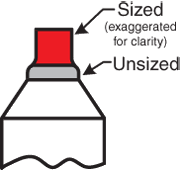"So what makes BoomTube the web expert? "


Ah, my friend, if only it were so. It's too cold to go out this morning so I have time to squander.
There are books FULL of stuff I don't know nor have even thought of. But the question here, NS vs. FLS isn't a complex one nor is it really unknown, on or off the web.
Neck sizing was initially done by Bench shooters with custom chambers and using selected, highly processed cases, often in chambers so tight the necks had to be turned thinner to even chamber. Many of their loads were sufficently low powered the cases rarely needed the shoulders set back from one firing to the next. THEY used neck sizing to advantage.
Of course when the rest of us heard about the wonders of neck sizing we just had to try it, if it was doing great things for BR guys it MUST be "better" for us too, right? Turns out that, like anything else in accuracy loading, it was/is/may be "better" for some guys but even when it is better the difference is so slight that, for HUNTERS, it's meaningless. BR competitions are won with top groups in the 1s and, at two hundered yards, 2s. For them, obtaining an average improvenment of 20 thou is tremendous. But for hunters, even varminters, surely you would agree that reducing the potential radius of error by some 10 thou will never be seen.
Fact is, a lot of experimentation has been done by a lot of highly competitent people in the years since BR shooting began. To surprise of many, neck sizing has proven to be so variable that it's no longer an article of faith even to them. It's been well documented - and reported - by both competitors AND bullet makers that FLS cases give them the best accuracy so it's not even a contest.
For those of us using factory rifles the potential is so small it just doesn't makie a difference from what we can do if we get everything right when we FLS. Testing quickly proves that accuracy is far less predictible than just shoulving a case into a neck die and saying we are now "precision" handloaders!
Hunting ammo, which is what this discussion has been about, needs to feed smoothly every time and sometimes it's nice to be able to share at camp. Sure, necked ammo usually feeds fine but not always, especially if a small bit of trash - leaf, etc, - gets into a chamber. When there is no practical benefit to neck sizing and there are some downsides, perhaps it's better not to do it?
The issue of case life is far more involved than simply the die we do our sizing in. To put it simply, no part of a case gets worked as much as the neck. The necks usually split first so, zilch gain for neck sizing!
One of the accuracy limits for any cases is the hardness of the necks and that gets worse as we cycle them. Best accuracy (usually) comes from new or nearly new cases and degrades as the necks work harden. Annealing can "fix" it but few of us are so good at annealing that we can restore all necks in the same batch to the same hardness so we end up with necks of varying hardness, not good for finest accuracy but plenty good for hunting ammo.
There are at least two ways we can filter BS. One is to discard things that "work for me"; it may be true but what works for me may very well not work for 90% of the rest of the world. The other is "most people do it this way" and "everybody knows it's best"; okay, so it must be right? I ask, how many people have to agree to an incorrect idea to make it correct? Seems most people go for simplistic answers without serious questioning alternate possibilites of doing thing better. (I cite that most voters went for Obama but I still don't agree they were right.)
I've been loading since '65. I'm a techical person, made my living building and maintaining precision electronic test/measurment equipment in the space and defense industries. I do examine a lot of reloading ideas and carefully test them on my personal range. I take nothing anyone says, nor even what I THINK, as true until I've tested it and on a statistically significant number of firearms and loads to be meaningful.
Im old enough and comfortable enough in my skin that I don't hang a touchy ego on my sleeve, I don't care a bit when others disagree with me. I just present my infomation to those with questions that interest me. If the poster I'm responding to wants to accept it okay, if he doesn't, still okay. But I REALLY don't care what others who come into the discussion think of what I say!

In the interest of learning I sometimes make arguments to pursue ideas but it's not personal. I do find it amusing that some experts seem to feel they
must "win" arguments with other anonymous posters on the web!

So, again, I sure don't know it all and don't try to present myself as an expert but I know what I know. For sure. YMMV.


